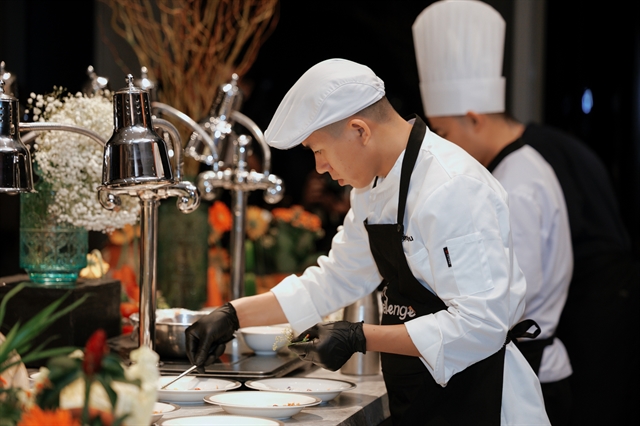Việt Nam and other Asia’s culinary hotspots are gaining international recognition for their vibrant and diverse food cultures, according to the latest report unveiled by Marriott International.

A chef at work. A new era of dining is emerging with the rise of "fine-casual" where comfort food meets creative refinement. -- Photo Courtesy of Marriott International
HCM CITY – Việt Nam and other Asia’s culinary hotspots are gaining international recognition for their vibrant and diverse food cultures, according to the latest report unveiled by Marriott International.
The Future of Food 2026, which explores how dining habits and preferences are changing across the Asia Pacific region, also named Indonesia, the Philippines and mainland China to the list and explores how these destinations are stepping onto the global culinary stage with renewed confidence and creativity.
The comprehensive study spotlights major trends reshaping the culinary landscape, including a shift away from traditional fine dining toward casual luxury, comfort-driven menus, immersive dining experiences and a renewed reverence for local flavours.
According to the report, diners are increasingly prioritising relaxed, personalised encounters where storytelling, entertainment, and thoughtful design are just as important as the food itself.
Drawing on insights from over 30 influential chefs, mixologists, industry insiders and regional food media, along with findings from Marriott’s inaugural regional survey of F&B teams in 270 properties across 20 Asia Pacific markets, the report explores how these emerging trends are redefining hospitality and guest expectations.
“The Future of Food 2026 showcases how Asia Pacific continues to shape the future of global dining,” said Petr Raba, Vice President of Food & Beverage, Asia Pacific excluding China, Marriott International.
“From the rise of casual luxury to experience-focused dining, today’s guests are seeking emotional connection as much as culinary excellence."
He added, “Across Asia, a new culinary language is emerging, one where quality meets comfort, luxury meets experience, and a meal is no longer just about eating, but about engaging all the senses. As our report shows, food is no longer just fuel; it’s a form of storytelling, identity, and cultural connection.”
A new era of dining is emerging with the rise of "fine-casual" where comfort food meets creative refinement. From elevated takes on beloved classics, such as caviar-topped fried chicken, to à la carte menus offering more choice and personality, chefs from Singapore to Tokyo are embracing a more relaxed yet luxurious approach.
As diners crave familiarity with a twist, high-profile chefs are reimagining everyday favourites with fine-dining finesse, creativity, and visual appeal. Traditional multi-course menus are giving way to faster, more flexible experiences.
Throughout Asia, dining is turning into a feast for all the senses, with guests choosing to dine in the dark or indulge in edible art. Chefs are embracing indigenous ingredients as integral components of their culinary identity, drawing on heritage and personal expression. There’s a growing emphasis on sourcing local, foraged and often forgotten ingredients to tell richer, more authentic food stories.
Among the Marriott International properties surveyed in Asia Pacific, 85 per cent now incorporate locally sourced ingredients or dishes into their offerings, signaling a growing appetite for seasonal food.
As AI becomes more embedded into the hospitality industry, it promises greater efficiency and highly personalised dining experiences. Advancements in technology will drive AI-powered menu engineering, leveraging real-time feedback and to optimize dish combinations and pricing.
Of the Marriott International properties surveyed across Asia Pacific, 76 per cent are adopting booking management technologies, while 75 per cent report that social media influences guest decisions around restaurant and bar bookings. While operators embrace these tools to automate tasks and enhance service, a key challenge remains in maintaining the human connection that defines true hospitality.
Trained in Michelin-starred kitchens, a new wave of third generation chefs is revolutionising Asian cuisines. Acting as cultural ambassadors, they employ modern cooking techniques and engage with native ingredients to elevate and refine the cuisine.
They are not just cooking; they are preserving heritage while charting a new course, proving that tradition and innovation can coexist harmoniously on the plate. This creative spirit extends to street vendors – or ‘hawkerpreneurs’ – who are adding luxe to laksa and sass to satays. – VNS




